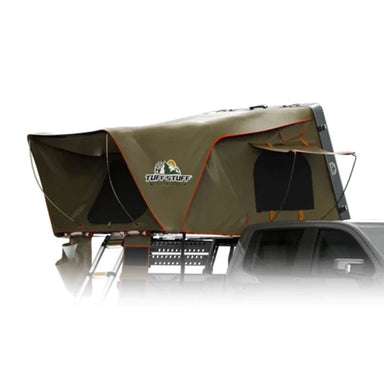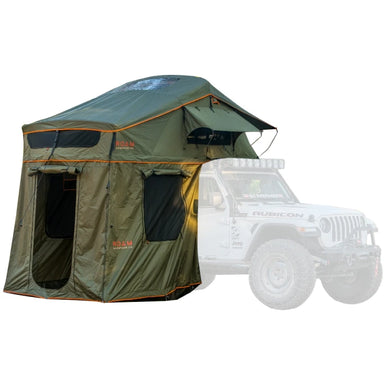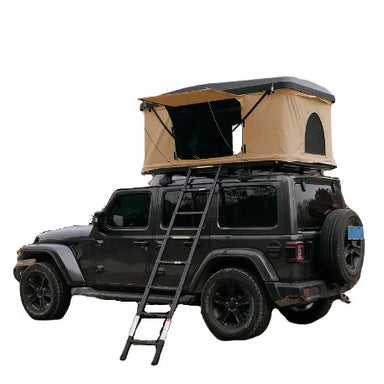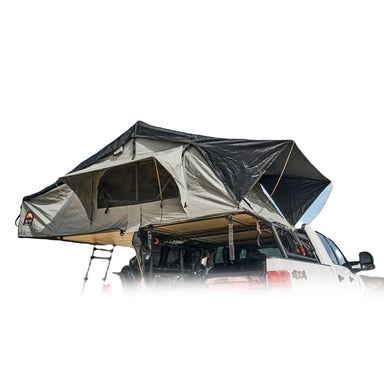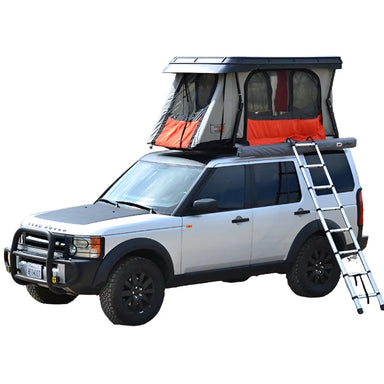One of the most common questions people ask about rooftop tents is, “Will a rooftop tent fit my vehicle?” The short answer: yes, it probably will. Most rooftop tents are designed to be universally compatible with standard crossbar roof rack systems. But the more important question to ask is, “How much weight can my vehicle safely carry on the roof?” If you want to dive into that topic, click here to jump to that section. Otherwise, keep reading for a general overview of rooftop tents and what you need to know before hitting the road.
-
Types of Rooftop Tents:
- Hardshell: These tents feature a durable, aerodynamic shell that folds out to form a tent. They're quick to set up and pack away, offering good protection from the elements.
- Softshell: Made of canvas or similar materials, these tents fold out from a rooftop carrier. They're generally lighter and easier to install but may take a bit longer to set up.
-
Benefits:
- Convenience: Rooftop tents are easy to set up and provide a comfortable sleeping area off the ground, away from potential wildlife and insects.
- Space: They often come with built-in mattresses and can accommodate two or more people comfortably.
- Versatility: Suitable for various vehicles like SUVs, trucks, and even some cars with roof racks.
-
Considerations:
- Vehicle Compatibility: Ensure your vehicle's roof rack system can support the weight of the tent and occupants.
- Setup: While generally straightforward, some models may be easier to set up than others. Hardshell tents typically offer quicker setup times.
- Weatherproofing: Check for features like rainflys, ventilation, and materials that handle different weather conditions.
-
Usage Tips:
- Installation: Follow the manufacturer's guidelines for installation and weight limits.
- Maintenance: Regularly check for wear and tear, especially on zippers, seams, and fabric. Clean according to the manufacturer's recommendations.
- Safety: Be mindful of wind conditions when setting up and using the tent. Some tents may be affected more by high winds than traditional ground tents.
-
Cost: Prices vary widely based on brand, features, and tent type. Expect to invest several hundred to over a thousand dollars for a quality rooftop tent.
-
Additional Features:
- Annex: Some rooftop tents come with an annex room that attaches beneath the tent, providing extra living or storage space.
- Accessories: Consider accessories like awnings, lighting, or gear storage solutions designed to complement rooftop tents.
Rooftop tents can significantly enhance your outdoor adventures by providing a comfortable and secure place to sleep while maximizing the utility of your vehicle.
Vehicle Weight Limits
The amount of weight a vehicle can support on its roof rack depends on several factors, but here are the key guidelines:
1. Vehicle Manufacturer’s Limit
- Typical roof load limits range from 100 to 200 lbs (45 to 90 kg) for most passenger vehicles.
- SUVs and larger vehicles may support up to 165–220 lbs (75–100 kg) or more.
- This limit includes the weight of the roof rack itself plus any cargo.
📘 Always check your vehicle’s owner manual for the official maximum roof load. They will provide a max weight for dynamic and static loads.
2. Dynamic vs. Static Load
- Dynamic load: The limit while the vehicle is moving — usually the number listed in manuals (e.g., 165 lbs). When choosing a rooftop tent, make sure it weighs less than this number.
- Static load: The limit while the vehicle is parked — can be 3–5 times higher, relevant for rooftop tents. This is how much weight your vehicle can hold total; including you, your friends, your gear, and your doggos!
3. Aftermarket Roof Rack Limits
- Brands like Thule, Yakima, or Rhino-Rack rate their racks up to 165 lbs (75 kg), but you're still limited by your vehicle’s own max load.
- You're always constrained by the lower of the roof or rack limits.
4. Weight Distribution
- It's important to evenly distribute weight across the rack.
- Heavier items should be centered and secured to prevent shifting.
- Rooftop tents are generally designed to distribute weight evenly.
Top 20 Vehicles for Rooftop Tents & Their Dynamic Roof Load Capacities
This list is just to give you a general idea of what your vehicle can hold. ALWAYS check your specific vehicles manual for the actual weight limits as this may vary between years and different trim levels.
| Vehicle | Max Dynamic Roof Load | Notes |
|---|---|---|
| Subaru Outback | 220 lbs | Aftermarket crossbars required for optimal capacity. |
| Ford Bronco | 110 lbs | Static load capacity significantly higher. |
| Jeep Wrangler | 150–165 lbs | Varies by model and year; consult owner's manual for specifics. |
| Toyota 4Runner | 120–165 lbs | Varies by model and year; consult owner's manual for specifics. |
| Land Rover Defender | 165–220 lbs | Higher capacity with aftermarket crossbars; consult owner's manual for specifics. |
| Toyota Tacoma | 165–220 lbs | Higher capacity with aftermarket crossbars; consult owner's manual for specifics. |
| Nissan Frontier | 150–165 lbs | Varies by model and year; consult owner's manual for specifics. |
| Ford F-150 | 150–165 lbs | Varies by model and year; consult owner's manual for specifics. |
| Chevrolet Colorado | 150–165 lbs | Varies by model and year; consult owner's manual for specifics. |
| Honda CR-V | 165 lbs | Aftermarket crossbars required for optimal capacity. |
| Mazda CX-5 | 165 lbs | Aftermarket crossbars required for optimal capacity. |
| Hyundai Santa Fe | 165 lbs | Aftermarket crossbars required for optimal capacity. |
| Kia Sorento | 165 lbs | Aftermarket crossbars required for optimal capacity. |
| BMW X5 | 220 lbs | Aftermarket crossbars required for optimal capacity. |
| Audi Q5 | 220 lbs | Aftermarket crossbars required for optimal capacity. |
| Mercedes-Benz G-Class | 220 lbs | Aftermarket crossbars required for optimal capacity. |
| Toyota Land Cruiser | 220 lbs | Aftermarket crossbars required for optimal capacity. |
| Nissan Xterra | 165 lbs | Aftermarket crossbars required for optimal capacity. |
| Chevrolet Tahoe | 220 lbs | Aftermarket crossbars required for optimal capacity. |
| GMC Yukon | 220 lbs | Aftermarket crossbars required for optimal capacity. |


